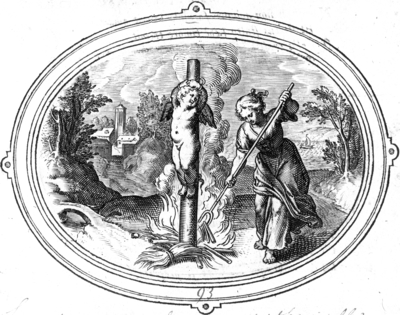Amor, qui desinere potest, numquam verus fuit [93]

AMOR, QVI DESINERE POTEST, NVMQVAM
VERVS FVIT.
 [Gratianus, Decretum
[Gratianus, Decretum , l1/l2/l3/l4/l5/plv/plp/plc. 2/33/3/2/2/187/1564/B]
[Paulinus, De salutaribus
, l1/l2/l3/l4/l5/plv/plp/plc. 2/33/3/2/2/187/1564/B]
[Paulinus, De salutaribus , ch/plv/plp/plc. 7/99/0202/A]
[Hieronymus, Epistolae
, ch/plv/plp/plc. 7/99/0202/A]
[Hieronymus, Epistolae , epist/sect/plv/plp. 3/6/22/335]
, epist/sect/plv/plp. 3/6/22/335]
VERVS FVIT.

 [Gratianus, Decretum
[Gratianus, Decretum , l1/l2/l3/l4/l5/plv/plp/plc. 2/33/3/2/2/187/1564/B]
[Paulinus, De salutaribus
, l1/l2/l3/l4/l5/plv/plp/plc. 2/33/3/2/2/187/1564/B]
[Paulinus, De salutaribus , ch/plv/plp/plc. 7/99/0202/A]
[Hieronymus, Epistolae
, ch/plv/plp/plc. 7/99/0202/A]
[Hieronymus, Epistolae , epist/sect/plv/plp. 3/6/22/335]
, epist/sect/plv/plp. 3/6/22/335]
Translations
 |
Liefde die kan eindigen, was nooit ware liefde. |
 |
Love that can end, was never true. |
 |
[Seneca] Zelfs al wordt hij aan het kruis genageld of in een vuur verbrand, dan nog al een echt minnaar liefhebben. |
 |
[Seneca] Even if he is nailed to the cross or burnt in a fire, a real lover will always love. |
Literature
- Praz, Seventeenth-Century Imagery
 , pp. 104-105
, pp. 104-105
- Sebastiàn, Lectura crítica
 , p. 42
, p. 42
Sources and parallels
- Amor, qui desinere potest, nunquam verus fuit [53] (in: Otto Vaenius, Emblemata aliquot selectiora amatoria (1618))
[Compare
![Compare [compare]](/static/images/compare2.gif) ]
]
- Porteman compares this emblem to: Martyrium amoris. [35] (in: anonymous, Amoris divini et humani antipathia (1628))
[Compare
![Compare [compare]](/static/images/compare2.gif) ]
]
- Ayres, Emblemata amatoria
 , embl. 22
, embl. 22 - Alciato, Book of Emblems
 , embl. 111
, embl. 111 -
A parallel (and probably source) for the motto, emblem carries another meaning: Ni mesme la mort [17] (in: Daniël Heinsius, Quaeris quid sit Amor (c. 1601))
[Compare
![Compare [compare]](/static/images/compare2.gif) ]
]
-
A parallel (and probably source) for the motto, emblem carries another meaning: Ni mesme la mort [17] (in: Daniël Heinsius, Emblemata amatoria (1607/8))
[Compare
![Compare [compare]](/static/images/compare2.gif) ]
]
-
Parallel for the pictura (mirrored, background less detailed) and for the Italian motto (as a part of): Un Amour attaché à une Colomne environnée d’un feu qu’une Dame attire (in: Daniel de la Feuille, Devises et emblemes (1691))
[Compare
![Compare [compare]](/static/images/compare2.gif) ]
]
-
A parallel (and probably source) for the motto, (the emblem carries another meaning): Ni mesme la mort [17] (in: Daniël Heinsius, Emblemata amatoria (1607/8))
[Compare
![Compare [compare]](/static/images/compare2.gif) ]
]
-
Parallel for the Seneca quote, pictura and subject in: Constans est [35] (in: Otto Vaenius, Amoris divini emblemata (1615))
[Compare
![Compare [compare]](/static/images/compare2.gif) ]
]
-
Pictura mirrored, different motto and Latin subscriptio, building in foreground, person being hanged by Cupid in
background:Laus in amore mori. [22] (in: anonymous, Emblemata amatoria (1690))
[Compare
![Compare [compare]](/static/images/compare2.gif) ]
]
References, across this site, to this page:
- Martyrium amoris. [35] (in: anonymous, Amoris divini et humani antipathia (1628))
- Laus in amore mori. [22] (in: anonymous, Emblemata amatoria (1690))
- Un Amour attaché à une Colomne environnée d’un feu qu’une Dame attire (in: Daniel de la Feuille, Devises et emblemes (1691))
- Ni mesme la mort [17] (in: Daniël Heinsius, Quaeris quid sit Amor (c. 1601))
- Ni mesme la mort [17] (in: Daniël Heinsius, Emblemata amatoria (1607/8))
- Amor æternus [5] (in: Otto Vaenius, Amoris divini emblemata (1615))
- Constans est [35] (in: Otto Vaenius, Amoris divini emblemata (1615))
- Amor, qui desinere potest, nunquam verus fuit [53] (in: Otto Vaenius, Emblemata aliquot selectiora amatoria (1618))
Iconclass
A woman stirring up the fire of the stake to which a cupid is tied- fire (one of the four elements)
[21C]

- landscape with tower or castle
[25I5]

- violent death by burning at the stake; pyre
[31E23121]

- couple of lovers (+ variant)
[33C23(+0)]

- Love vanquished; 'Amor Domato' (Ripa)
[33C99]

- burning as process: log
[41B12(LOG)]

- stirring up a fire
[41B13]

- instruments of torture, execution or punishment: stake
[44G321(STAKE)]

- agricultural implements: pitchfork
[47I15(PITCHFORK)]

- Constancy, Tenacity; 'Costanza', 'Tenacité' (Ripa) (+ emblematical representation of concept)
[53A21(+4)]

- (personifications and symbolic representations of) Love; 'Amore (secondo Seneca)' (Ripa) (+ emblematical representation of
concept)
[56F2(+4)]

- Mortality, Extinction of Life (+ emblematical representation of concept)
[58BB1(+4)]

- proverbs, sayings, etc. (with TEXT)
[86(AMOR, QUI DESINERE POTEST, NUMQUAM VERUS FUIT)]

- punishment of Cupid
[92D161]

![[H O M E : Emblem Project Utrecht]](/static/images/rd-small.gif)


















































































































































